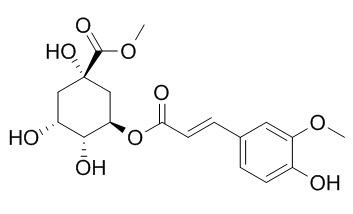Methyl 3-O-feruloylquinate
Methyl 3-O-feruloylquinate inhibits the activity of bacteria and viruses and to regulate immunity.
Inquire / Order:
manager@chemfaces.com
Technical Inquiries:
service@chemfaces.com
Tel:
+86-27-84237783
Fax:
+86-27-84254680
Address:
1 Building, No. 83, CheCheng Rd., Wuhan Economic and Technological Development Zone, Wuhan, Hubei 430056, PRC
Providing storage is as stated on the product vial and the vial is kept tightly sealed, the product can be stored for up to
24 months(2-8C).
Wherever possible, you should prepare and use solutions on the same day. However, if you need to make up stock solutions in advance, we recommend that you store the solution as aliquots in tightly sealed vials at -20C. Generally, these will be useable for up to two weeks. Before use, and prior to opening the vial we recommend that you allow your product to equilibrate to room temperature for at least 1 hour.
Need more advice on solubility, usage and handling? Please email to: service@chemfaces.com
The packaging of the product may have turned upside down during transportation, resulting in the natural compounds adhering to the neck or cap of the vial. take the vial out of its packaging and gently shake to let the compounds fall to the bottom of the vial. for liquid products, centrifuge at 200-500 RPM to gather the liquid at the bottom of the vial. try to avoid loss or contamination during handling.
Dermatologica Sinica2024, 42(1):p19-30.
J Food Sci Technol.2022, 59(1):212-219.
Food Bioscience2023, 52:102412
Mol Plant Pathol.2022, 10.1111:mpp.13280.
Oxid Med Cell Longev.2021, 2021:6647107.
Food Chem.2021, 360:130063.
Nutrients.2022, 14(23):4997.
Planta Med.2023, a-2192-2281.
Molecules.2023, 28(8):3414.
Molecules.2021, 26(19):6032.
Related and Featured Products
Yao Xue Xue Bao. 2015 Feb;50(2):207-10.
Chemical constituents of the roots of Macleaya microcarpa and activation efficacy of benzophenanthridine alkaloids for the transcription of xbp1 gene.[Pubmed:
25975030]
Ongoing study on the chemical constituents of the roots of Macleaya microcarpa led to the isolation of eight compounds of derivatives of triterpenes and organic acids in addition to some previously identified benzophenanthridines.
METHODS AND RESULTS:
The eight compounds were identified by spectroscopic methods as well as comparison with literature values as 1-oxo-2, 22 (30)-hopandien-29-oic acid (1), 3-oxo-12-oleanen-30-oic acid (2), 3α-hydroxy-12-oleanen-30-oic acid (3), 3β-hydroxy-12-oleanen-30-oic acid (4), ferulic acid (5), ferulic acid 4-O-β-D-glucoside (6), 3-O-feruloylquinic acid (7), and Methyl 3-O-feruloylquinate (8). Of which, 1 is a new triterpenoid of hopanes and 2-8 are isolated from M microcarpa for the first time. In order to discover natural active compounds as potential agents of anti-ulcerative colitis (UC), an in vitro drug high-throughput screening model targeted x-box-binding protein 1 (xbp1) was employed to evaluate the activity of the major chemical constituents of M microcarpa.
CONCLUSIONS:
The result confirmed that two dihydrobenzophenanthridines, dihydrosanguinarine (9) and dihydrochelerythrine (10), showed a certain activity on activating the transcription of xbpl, a transcription factor (TF) associated with the occurrence, development, and potential treatment of UC, with their relative activating ratios being 1.76 and 1.77 times, respectively, as compared with control group.
Biomed Res Int. 2014;2014:761849.
Possible inhibitor from traditional Chinese medicine for the β form of calcium-dependent protein kinase type II in the treatment of major depressive disorder.[Pubmed:
25045698]
Recently, an important topic of major depressive disorder (MDD) had been published in 2013. MDD is one of the most prevalent and disabling mental disorders. Consequently, much research is being undertaken into the causes and treatment. It has been found that inhibition of the β form of calcium/calmodulin-dependent protein kinase type II (β-CaMKII) can ameliorate the disorder.
METHODS AND RESULTS:
Upon screening the traditional Chinese medicine (TCM) database by molecular docking, sengesterone, labiatic acid, and Methyl 3-O-feruloylquinate were selected for molecular dynamics.
Biomed Res Int. 2014;2014:635152.
The inhibition of folylpolyglutamate synthetase (folC) in the prevention of drug resistance in Mycobacterium tuberculosis by traditional Chinese medicine.[Pubmed:
25050369]
The selected TCM compounds Saussureamine C, Methyl 3-O-feruloylquinate, and Labiatic acid have been found to inhibit the activity of bacteria and viruses and to regulate immunity. We also suggest the possible pathway in protein for each ligand. Compared with the control, similar interactions and structural variations indicate that these compounds might have an effect on Folylpolyglutamate synthetase.
CONCLUSIONS:
Finally, we suggest Saussureamine C is the best candidate compound as the complex has a high score, maintains its structural composition, and has a larger variation value than the control, thus inhibiting the drug resistance ability of Mycobacterium tuberculosis.
3,3',4',5,6,7,8-heptamethoxyflavone
Catalog No: CFN95021
CAS No: 1178-24-1
Price: $268/10mg
Oleuroside
Catalog No: CFN95099
CAS No: 116383-31-4
Price: $288/20mg
3,7,25-Trihydroxycucurbita-5,23-dien-19-al
Catalog No: CFN95150
CAS No: 85372-65-2
Price: $318/5mg
9-Hydroxy-O-senecioyl-8,9-dihydrooroselol
Catalog No: CFN95274
CAS No: 31456-63-0
Price: $318/5mg
Isoengeletin
Catalog No: CFN95284
CAS No: 30987-58-7
Price: $318/5mg
Phloretin 3',5'-Di-C-glucoside
Catalog No: CFN95306
CAS No: 357401-40-2
Price: $318/10mg
threo-Guaiacylglycerol-beta-coniferyl aldehyde ether
Catalog No: CFN95417
CAS No: 650600-33-2
Price: $318/5mg
4-Methoxybenzoylacetic acid
Catalog No: CFN95446
CAS No: 13422-77-0
Price: $318/5mg
Malabaricone C
Catalog No: CFN95475
CAS No: 63335-25-1
Price: $318/10mg
Nomilinic acid
Catalog No: CFN95559
CAS No: 35930-20-2
Price: $318/5mg



